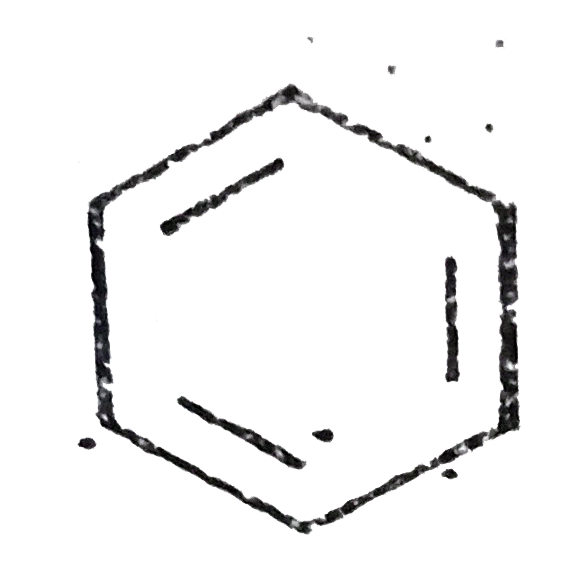Which of the following hydrocarbon is most stable ?
1.
2. 
3. 
4. 
The correct Answer is:A
To determine which hydrocarbon is the most stable among the given options, we will analyze each structure based on their bonding, presence of conjugation, and adherence to Huckel's rule.
1. Identify the Structures:
- Let's denote the four hydrocarbons as A, B, C, and D for simplicity.
- A is a 5-membered cyclic structure with two double bonds.
- B is a simple alkene with no conjugation.
- C has one pi bond and lacks any charge or conjugation.
- D is a cyclic structure with alternating double and single bonds.
2. Analyze Structure A:
- Structure A has two double bonds but does not exhibit conjugation.
- Since it is not aromatic and lacks resonance, its stability is limited.
Hint: Look for the presence of conjugation and aromaticity in cyclic compounds.
3. Analyze Structure B:
- Structure B is a simple alkene with no conjugation.
- Alkenes are generally less stable than cyclic compounds with resonance or conjugation.
Hint: Remember that alkenes without conjugation are less stable compared to cyclic structures.
4. Analyze Structure C:
- Structure C has only one pi bond.
- It lacks charge and conjugation, making it less stable than compounds with resonance.
Hint: Consider the role of charge and conjugation in enhancing stability.
5. Analyze Structure D:
- Structure D has alternating double and single bonds, indicating conjugation.
- It follows Huckel's rule (4n + 2 pi electrons), which states that a compound is aromatic and thus more stable if it has 6 pi electrons.
- The presence of resonance in this structure significantly enhances its stability.
Hint: Recall Huckel's rule for aromatic compounds: 4n + 2 pi electrons indicate aromatic stability.
6. Conclusion:
- Among the four structures, Structure D (benzene) is the most stable due to its aromatic nature and the presence of conjugation.
- Therefore, the answer is that the fourth structure, benzene, is the most stable hydrocarbon.
Final Answer:
The most stable hydrocarbon among the given options is benzene (Structure D).
- Let's denote the four hydrocarbons as A, B, C, and D for simplicity.
- A is a 5-membered cyclic structure with two double bonds.
- B is a simple alkene with no conjugation.
- C has one pi bond and lacks any charge or conjugation.
- D is a cyclic structure with alternating double and single bonds.
- Structure A has two double bonds but does not exhibit conjugation.
- Since it is not aromatic and lacks resonance, its stability is limited.
- Structure B is a simple alkene with no conjugation.
- Alkenes are generally less stable than cyclic compounds with resonance or conjugation.
- Structure C has only one pi bond.
- It lacks charge and conjugation, making it less stable than compounds with resonance.
- Structure D has alternating double and single bonds, indicating conjugation.
- It follows Huckel's rule (4n + 2 pi electrons), which states that a compound is aromatic and thus more stable if it has 6 pi electrons.
- The presence of resonance in this structure significantly enhances its stability.
- Among the four structures, Structure D (benzene) is the most stable due to its aromatic nature and the presence of conjugation.
- Therefore, the answer is that the fourth structure, benzene, is the most stable hydrocarbon.
The most stable hydrocarbon among the given options is benzene (Structure D).
Topper's Solved these Questions
- ORGANIC CHEMISTRY: SOME BASIC PRINCIPLE AND TECHNIQUESBook:AAKASH INSTITUTE ENGLISHChapter:ORGANIC CHEMISTRY: SOME BASIC PRINCIPLE AND TECHNIQUESExercise:SECTION-C OBJECTIVE TYPE QUESTION (MORE THAN ONE OPTIONS ARE CORRECT)
Explore 18 Videos
- ORGANIC CHEMISTRY: SOME BASIC PRINCIPLE AND TECHNIQUESBook:AAKASH INSTITUTE ENGLISHChapter:ORGANIC CHEMISTRY: SOME BASIC PRINCIPLE AND TECHNIQUESExercise:SECTION-D LINKED COMPREHENSION TYPE QUESTIONS
Explore 7 Videos
- ORGANIC CHEMISTRY: SOME BASIC PRINCIPLE AND TECHNIQUESBook:AAKASH INSTITUTE ENGLISHChapter:ORGANIC CHEMISTRY: SOME BASIC PRINCIPLE AND TECHNIQUESExercise:ASSIGNMENT SECTION-A COMPETITION LEVEL QUESTIONS
Explore 50 Videos
- ORGANIC CHEMISTRY : SOME BASIC PRINCIPLES AND TECHNIQUES Book:AAKASH INSTITUTE ENGLISHChapter:ORGANIC CHEMISTRY : SOME BASIC PRINCIPLES AND TECHNIQUES Exercise:Assignment(Section-D)(Assertion - Reason Type Questions)
Explore 15 Videos
- POLYMERSBook:AAKASH INSTITUTE ENGLISHChapter:POLYMERSExercise:ASSIGNMENT (SECTION-D)
Explore 13 Videos
Similar Questions
Knowledge Check
Which of the following carbanions is most stable?
ACH3−өCH2BCH2=CH−өCH2CCH3−O∣∣C−өCH2DCH3−NH∣∣C−өCH2Which of the following cations is most stable?
A B
B C
C D
D
Which of the following cations is most stable?
A B
B C
C D
D
Which of the following carbocations is most stable ?

View SolutionWhich of the following carbocation is most stable?
View SolutionWhich of the following carbocations is most stable ?
View SolutionWhich one of the following carbanions is most stable ?
View SolutionWhich of the following compounds is most stable ?
View Solution